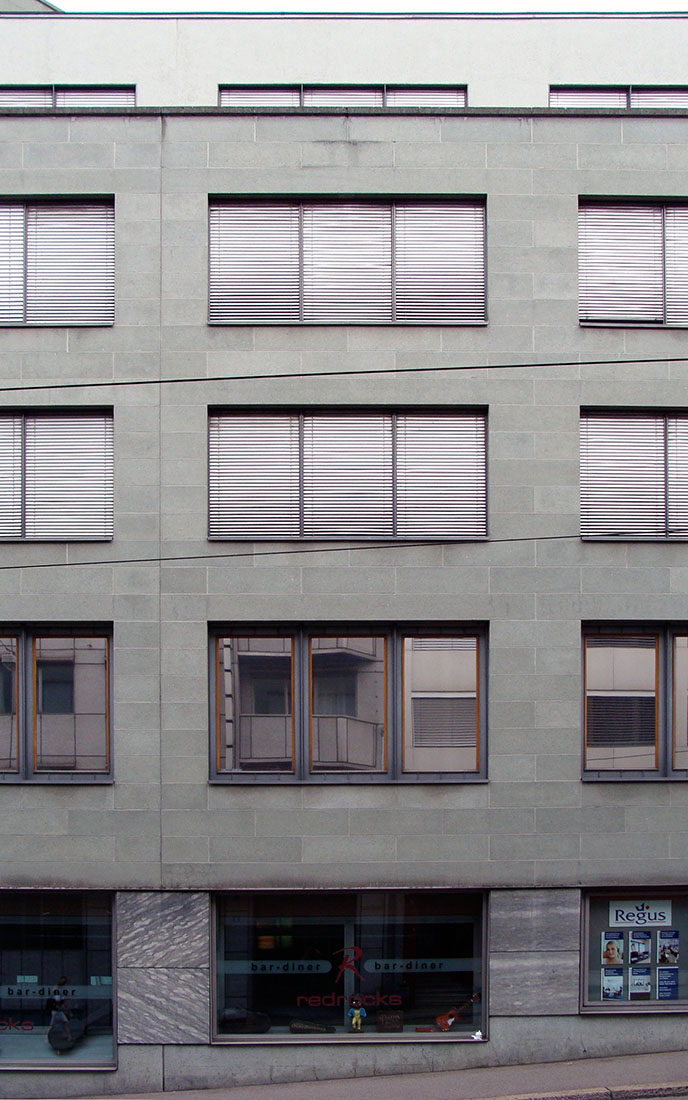 |
 |
 |
 |


Office Building Steinentorberg
Steinentorberg 8 - 12, Basel
1984 - 1990
The
office Building Steinentorberg is located in the inner-city Heuwaag
area of Basel. This impressive building was commissioned by the trust
and treasury services company Fides.
Several smaller nineteenth-century neo-Gothic and older buildings were replaced by this new office building. Main feature of this building is a long facade measuring nearly 150 m,
and facing the Heuwaag viaduct. This viaduct is an overpass which was constructed in the 1960s a midst of a cluster of smaller historic city buildings. The Steinentorberg
office building was errected on a triangular site with an acute-angled street corner at its lowest point. The corner situation is articulated by a closed and curved piece of facade.
The building consists of two wings which enclose a inner courtyard. The resulting two street elevations are made of a greenish concrete stone. With this office building,
Diener & Diener introduced a new building scale in this area of the city, while at the same time manifesting an urban inner-city quality. With its large horizontal expansion
the building enters into a dialogue with the adjacent market hall. The market-hall with its octagonal cupola is also of a larger scale and is considered a landmark
with its bold construction of reinforced concrete from the late 1920s.
Three stories of the building are completely buried underground and a fourth level peeks out of the ground only at the bottom point of the hill and forms the base together
with the ground floor. This base has a facade of red-stained concrete and embeds the volume in the slope of the street. Above this base are five stories of the building,
which are clad with large elements measuring 140 by 40 cm. These elements are 12 cm thick and have an average weight of 150 kg. They are made of concrete and
receive their greenish colour from the addition of granite from Andeer. The size of these elements indicates their industrial origin, and the thin cement joints seem to
be compacted by their weight. The horizontallity of the building is supported by the long windows, each consisting of five casement frames, and the dimensions of the
mentioned artifical and sandblasted blocks.
The rear side the building faces a courtyard. The volume of the long tract is set back at each of the three floors, until it meets the volume of the greenish concrete stone.
This stepped volume is made of reinforced concrete and is plastered with an ochre-coloured stucco. Olive green paint was used for the window-frames and the doors on this
terraced volume. This use of color sets up a subtle tension with the green stones of the front-facing volume, but also communicates with the landscape architecture of the couryard.
Several smaller nineteenth-century neo-Gothic and older buildings were replaced by this new office building. Main feature of this building is a long facade measuring nearly 150 m,
and facing the Heuwaag viaduct. This viaduct is an overpass which was constructed in the 1960s a midst of a cluster of smaller historic city buildings. The Steinentorberg
office building was errected on a triangular site with an acute-angled street corner at its lowest point. The corner situation is articulated by a closed and curved piece of facade.
The building consists of two wings which enclose a inner courtyard. The resulting two street elevations are made of a greenish concrete stone. With this office building,
Diener & Diener introduced a new building scale in this area of the city, while at the same time manifesting an urban inner-city quality. With its large horizontal expansion
the building enters into a dialogue with the adjacent market hall. The market-hall with its octagonal cupola is also of a larger scale and is considered a landmark
with its bold construction of reinforced concrete from the late 1920s.
Three stories of the building are completely buried underground and a fourth level peeks out of the ground only at the bottom point of the hill and forms the base together
with the ground floor. This base has a facade of red-stained concrete and embeds the volume in the slope of the street. Above this base are five stories of the building,
which are clad with large elements measuring 140 by 40 cm. These elements are 12 cm thick and have an average weight of 150 kg. They are made of concrete and
receive their greenish colour from the addition of granite from Andeer. The size of these elements indicates their industrial origin, and the thin cement joints seem to
be compacted by their weight. The horizontallity of the building is supported by the long windows, each consisting of five casement frames, and the dimensions of the
mentioned artifical and sandblasted blocks.
The rear side the building faces a courtyard. The volume of the long tract is set back at each of the three floors, until it meets the volume of the greenish concrete stone.
This stepped volume is made of reinforced concrete and is plastered with an ochre-coloured stucco. Olive green paint was used for the window-frames and the doors on this
terraced volume. This use of color sets up a subtle tension with the green stones of the front-facing volume, but also communicates with the landscape architecture of the couryard.